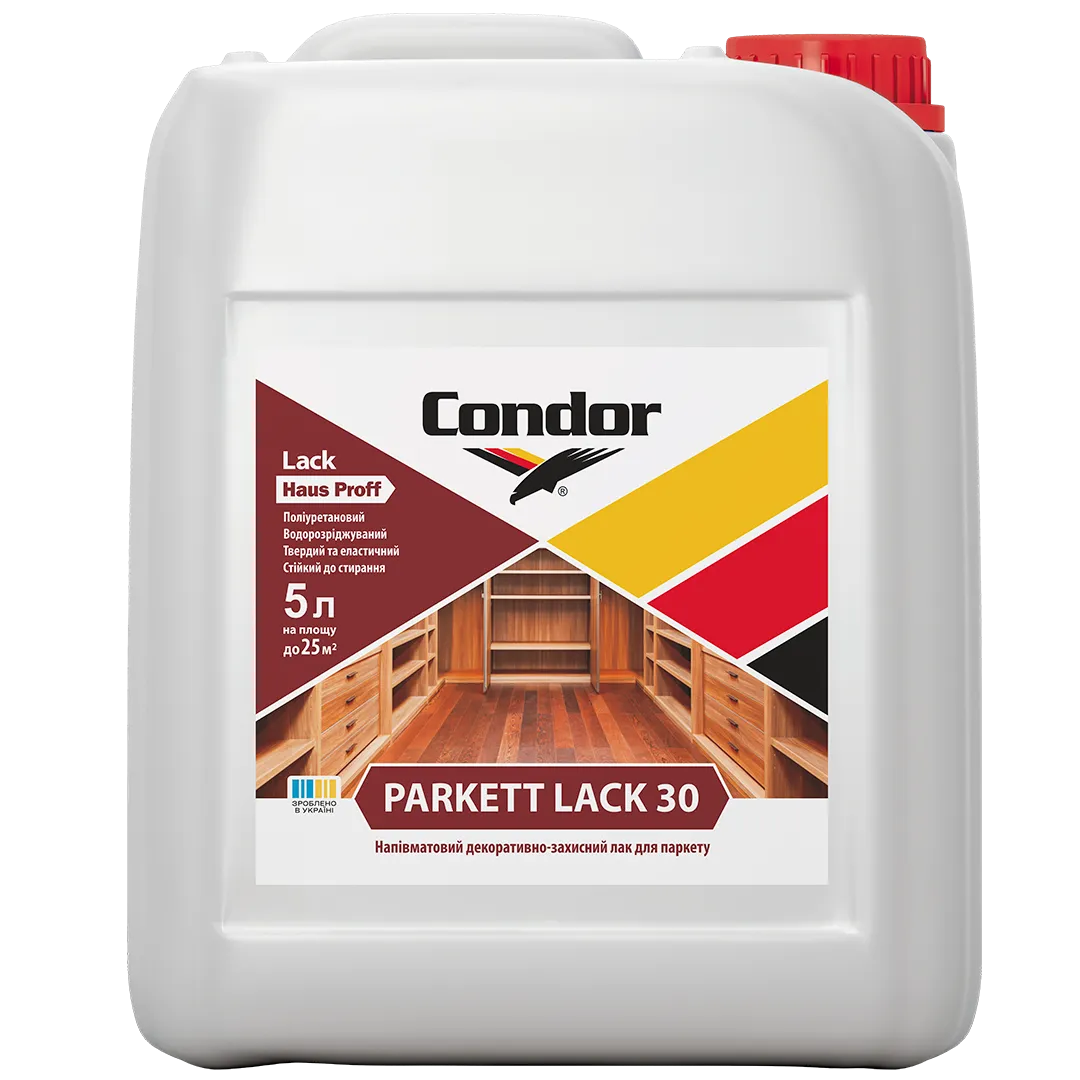Condor
Parkett Lack 30
- Semi-matte
- Polyurethane
- Water-based
- Hard and elastic
- Abrasion-resistant





Properties Semi-matte water-based polyurethane parquet varnish. - Emphasizes the structure of the wood. - Excellently protects the surface from damage, dirt (domestic pollutants) and moisture penetration. - Withstands intense mechanical stress from abrasion. - Resistant to most household chemicals. - Forms a strong and elastic transparent colorless film. - Does not change the color of the wood. - Does not turn yellow. - Has no unpleasant odor. - Spreads well on the surface, dries quickly. - Has good adhesion to different types of wood. - The VOC content (volatile organic compounds) complies with European Union Directive 2004/42/EC. - Withstands repeated wet cleaning using neutral, non-abrasive detergents. - Do not use hard brushes and sponges, as well as organic solvents for cleaning. - When installing furniture, use special pads for the legs. Maximum permissible VOC content for the product (subgroup e) 130 g/L (2010). Max. VOC content in the product < 100 g/L. Hardness: - 100 (Koenig method, 7 days, DSTU ISO 1522:2015) Abrasion resistance: - < 15 mg (Taber Abraser/ cs-10/ 1000 cycles/ 1000 grams) Wet abrasion resistance: - Class 1 (DSTU EN 13300:2024). Purpose Decorative and protective polyurethane semi-matt water-based varnish for parquet. For new or previously painted surfaces. For interior work in residential and public premises with normal and high humidity. For "moving" floors and heated floors. The varnish is not intended for baths (saunas). Types of surfaces for application For wooden parquet: firmly glued mosaic, artificial, end, sheet (laminated). For wooden floors, wooden stair treads and railings. The varnish can be used for all wooden interior elements (tabletops, furniture, windows, doors, etc.), as well as wood materials (fiberboard, chipboard, MDF, OSB, cork, etc.).
Surface preparation
Surface: dry, solid, clean, degreased, dust-free. Wood moisture content less than 18%.
New surface (or previously varnished surface with varnish removal): For maximum adhesion and strength of the varnish film, treat new wood or wood completely cleaned of old coatings (varnish, paint, wax, oil, polish, silicone, parquet care products, etc.). Completely remove the layer of wood impregnated with oil (cycle) to the depth of oil penetration. Degrease the treated surfaces of tropical wood, hardwood (oak, beech) and resinous sticky wood. Lightly moisten rough wood with water, after drying, remove the raised pile by sanding. The first sanding of the wood should be done with coarse sandpaper. When sanding, smooth the surface as much as possible. Finish sanding before priming (or before applying tinting material) should be done with fine sandpaper (240), remove dust. Prime the prepared surface with one layer of primer. For priming, use PARKETT ELIT varnish diluted with water by 10–15% at a consumption of 10–15 m2/l. For priming, you can use a pore filler (acrylic or nitrocellulose) for wood. Priming tool: varnish roller (or brush). After priming (after 4 hours), sand the dried surface with fine sandpaper (240), removing any raised pile. Remove dust. Before applying varnish, check the compatibility with the surface of the wood being treated on a small area. Some exotic and hard wood species may change color dramatically. In all cases, remove dust from the surface to be treated and from surrounding elements with a vacuum cleaner, and then with a clean, damp, lint-free cloth.
Previously varnished surface (without removing the varnish coating): Clean the surface of old, peeling varnish. Carefully, without applying much force, sand the entire surface with fine sandpaper (240). Remove dust. Do not prime previously varnished surfaces. Check the compatibility of the varnish with the old varnish coating by performing a test varnishing on a small area.
Application
Stir the varnish before use and stir during use. Apply at a relative humidity of 40–70%, air, substrate and varnish temperature from +15 ºС to +25 ºС with a varnish roller or varnish spatula. On small areas, a brush can be used. Application with a roller (brush): 2–3 layers. Application with a spatula: 4–5 layers. Apply the varnish in the direction of the light falling on the room or along the wood fibers from edge to edge of the surface. Before applying the last layer of varnish, sand the surface with sandpaper (240), remove dust. Attention! Do not apply the varnish in thick layers with excessive material consumption. Applying the varnish in conditions of direct sunlight, drafts, dustiness of the room, increased (or decreased) temperature and humidity can lead to coating defects.
Working tools
Varnish roller, varnish spatula, brush.
Cleaning of tools
Rinse with water immediately after use. Dried varnish can be cleaned mechanically.
Polyurethane dispersion, water, additives. UA VOC limit value for this product (Cat. A/e): 130 g/l (g/l). This product contains max 130 g/l (g/l) VOC.
Safety equipment
During work, follow general occupational hygiene rules. Work in a ventilated area, wear work clothes, gloves. Keep out of reach of children. In case of contact with skin or eyes, rinse with water. The varnish is fire and explosion-proof.
Disposal
Remains of dried varnish should be disposed of as household waste, polymer containers should be collected for recycling or disposed of as household waste.
0.75 l (0.78 kg); 3 l (3.12 kg); 5 l (5.2 kg)




